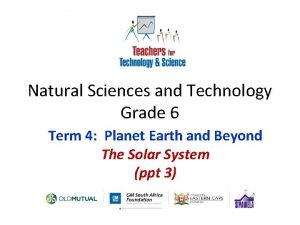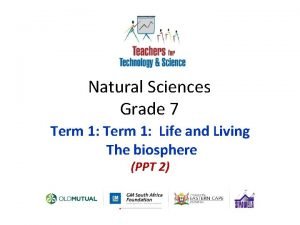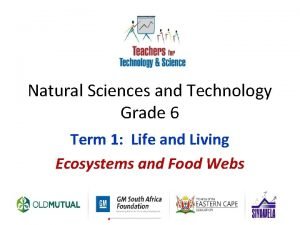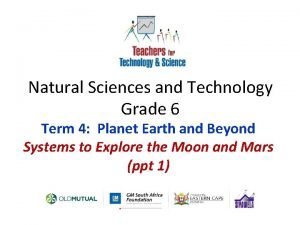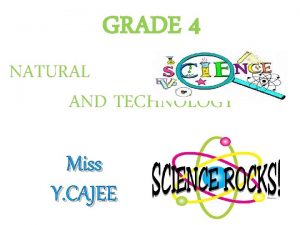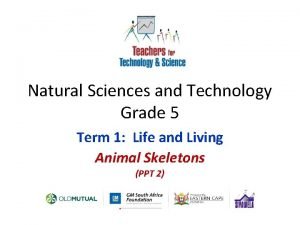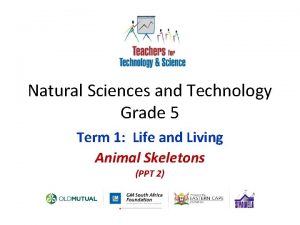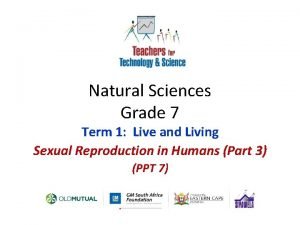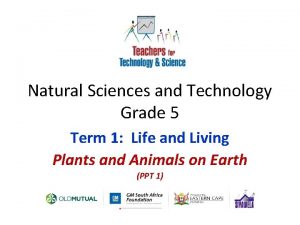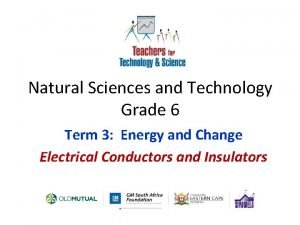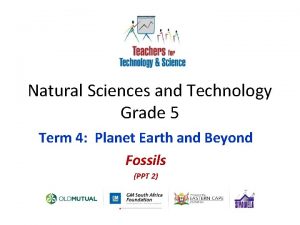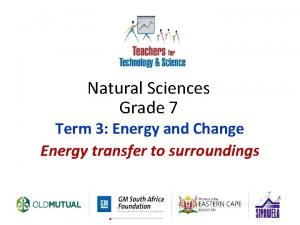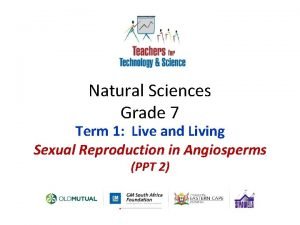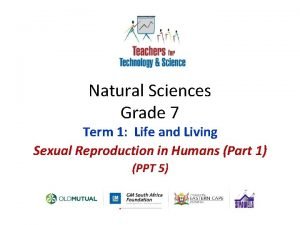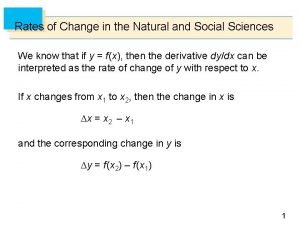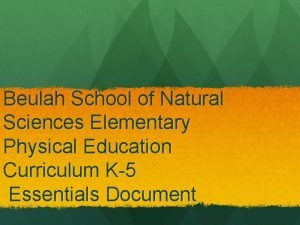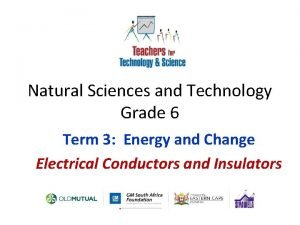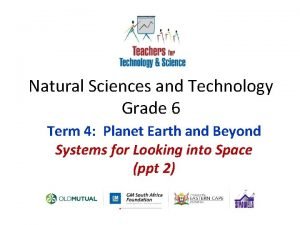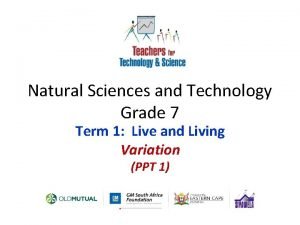Natural Sciences Grade 7 Term 1 Live and























- Slides: 23

Natural Sciences Grade 7 Term 1: Live and Living Sexual Reproduction in Angiosperms (PPT 2)

Topic 3 Sexual Reproduction Pollination Natural Sciences – Grade 7

Process of sexual production in Angiosperms 4 Steps in the life cycle of a plant: 1. 2. 3. 4. pollination fertilisation seeds and fruits form seeds germinate and new plants grow Natural Sciences - Grade 7

Pollination It is the transfer of pollen from the anther to the stigma. • Pollen is spread by pollinators. – Examples: insects, birds and mammals • Flowers are adapted to the various methods of pollination. Natural Sciences - Grade 7

Wind pollination Grasses is an example of wind pollinated flowers: • they sit at the tips of long stems • they do NOT have bright petals, nectar or a scent. • their pollen is very small and light. • they have long stigmas and filaments that hang out of the flowers. Natural Sciences - Grade 7

Wind pollination • These flowers produce a large amount of pollen. • This increases the chances of pollen landing on stigmas. Natural Sciences - Grade 7

Pollination by Water • Plants that live in water are usually pollinated by the movement of water. • The pollen grains from the stamen of the one plant will be carried across the surface of the water to the pistal of another flower. Natural Sciences - Grade 7

Pollination by water Natural Sciences - Grade 7

Pollination by insects and birds • Insects, birds, bats and mice are important pollinators of plants. • These insects and animals rely on pollen and nectar as food. Natural Sciences - Grade 7

Insect pollinated flowers • have a sweet scent • are brightly coloured - usually blue, red, white or purple • produce nectar • produce sticky pollen to stick to the insect • have stamens and a stigma inside the flower Natural Sciences - Grade 7

Pollination by insects Natural Sciences - Grade 7

Bird pollinated flowers • have brightly coloured petals - usually red, yellow and orange • have no scent • produce large amounts of nectar • flowers are tube shaped • have long stamens and stigmas Natural Sciences - Grade 7

Flowers are adapted for pollination Flowers have evolved over time and have adapted to the way in which they are pollinated. Adapted means: to be suited to the particular conditions; how the plant looks and behaves to survive where it lives. Animal pollinators have also evolved over time to pollinate a particular flower. Natural Sciences - Grade 7

Flowers are adapted for pollination To pollinate a type of flower, the animal must – • visit that type of flower regularly, e. g. for food • prefer that type of flower so that it can carry the right kind of pollen as it moves from flower to flower The plant must • give a reward, e. g. food or something • attract the animal, e. g. smell, colour or shape • be shaped in such a way that it puts pollen on that particular size and shape of animal Natural Sciences - Grade 7

Adaptations for insect pollination Insect pollinated plants usually have – • brightly coloured petals • sugar-rich nectar • honey-guides • stigma and style in the correct position to dust pollen onto the insect or to pull it off the insect • a landing platform for the insect Natural Sciences - Grade 7

Adaptation facts: moths • moths fly mostly at night • moth pollinated flowers are usually white or very pale with a strong night scent (smell) Natural Sciences - Grade 7

Adaptation facts: bees The shape and colour of the flower will depend on the type of insect that pollinates it, for example – • bees cannot see red colours • bee-pollinated flowers are usually yellow, blue or ultra-violet Natural Sciences - Grade 7

How do bees pollinate flowers? • bees collect nectar from a young flower • the hairs on the bees’ bodies get brushed with pollen from the ripe stamen • the stamen shrivels up • the stigma ripens and moves into position • bees are attracted by nectar from the older flower • some of the pollen on them will enter the flower and the sticky stigma brushes the pollen off. Natural Sciences - Grade 7

Pollination by bees Natural Sciences - Grade 7

Adaptations for bird pollination Bird pollinated plants usually have – • brightly coloured petals • sugar-rich nectar • large size with narrow tube wide enough for a bird’s beak, but too narrow for insects to eat the nectar • stigma and style in the correct position to dust pollen onto the bird’s feather or to pull it off • a strong stalk as a landing platform for the bird to perch on or flowers hang well out of the plant so the birds can feed by hovering in front of the flower Natural Sciences - Grade 7

Adaptation facts: birds • birds are attracted to red colours • birds have a weak sense of smell, so birdpollinated flowers are often not scented Natural Sciences - Grade 7

Pollination by birds Natural Sciences - Grade 7

Humans depend on pollinators • We depend on seeds for our food crops. Without pollination, there will not be any seeds. • Wind pollinated crops such as cereals are grown in large blocks close together e. g. maize, rice and wheat. • Animal pollinated crops are mostly pollinated by bees. In fruit and vegetable growing areas, beekeepers move hives from one orchard to another in fruit and vegetable growing areas: ofruits, e. g. apples, pears, citrus ovegetables, e. g. peas, beans, marrows and tomatoes Natural Sciences - Grade 7
 Ns grade 6 term 4
Ns grade 6 term 4 Grade 6 term 2 natural science
Grade 6 term 2 natural science Biosphere grade 7
Biosphere grade 7 Natural science grade 7 term 4
Natural science grade 7 term 4 Natural science grade 7 term 3 test
Natural science grade 7 term 3 test Natural sciences tok
Natural sciences tok Physical properties of materials grade 7
Physical properties of materials grade 7 Natural science grade 7 term 2 notes
Natural science grade 7 term 2 notes Grade 6 natural science term 1
Grade 6 natural science term 1 Natural science grade 6 term 4
Natural science grade 6 term 4 Grade 4 natural science test term 3
Grade 4 natural science test term 3 Technology grade 7 term 2 structures
Technology grade 7 term 2 structures Natural science grade 5
Natural science grade 5 Natural science grade 7 term 3 notes
Natural science grade 7 term 3 notes Grade 5 natural science term 1
Grade 5 natural science term 1 Grade 6 term 3 natural science
Grade 6 term 3 natural science Natural science grade 5 term 4
Natural science grade 5 term 4 Natural science grade 7 term 3
Natural science grade 7 term 3 Energy and change grade 7
Energy and change grade 7 Anemophily
Anemophily Heat transfer grade 7
Heat transfer grade 7 Life and living grade 7
Life and living grade 7 Rates of change in the natural and social sciences
Rates of change in the natural and social sciences Beulah school of natural sciences
Beulah school of natural sciences
